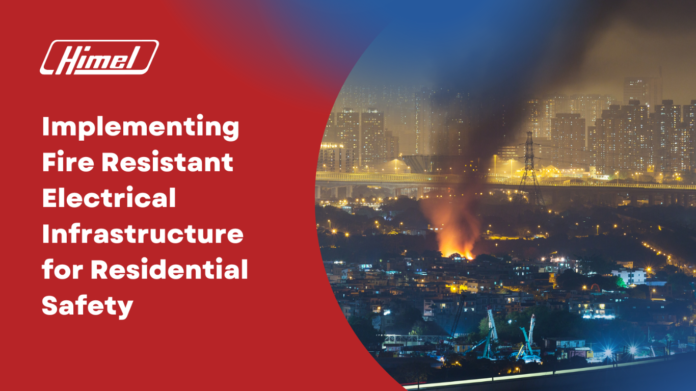In our pursuit of progress, one aspect that often goes unnoticed is the increasing threat posed by residential fires. These devastating incidents not only claim lives but also result in substantial property damage. Unfortunately, electrical mishaps stand out as a significant contributor to residential fires. The potential for electrical short circuits, overloads, and other anomalies can have catastrophic consequences, transforming homes into infernos in a matter of moments.
To effectively address this pressing challenge, a proactive approach is essential, one that prioritizes the implementation of fire-resistant electrical infrastructure as a fundamental pillar of residential safety.
Recent statistics paint a grim picture, emphasizing the gravity of the situation. According to the National Fire Protection Association (NFPA), in 2022 alone, there were approximately 382,500 residential fires reported in the United States, causing 2,760 civilian deaths and 10,320 injuries. The financial toll is equally alarming, with an estimated $10.9 billion in direct property damage resulting from these incidents.
Globally, the World Health Organization (WHO) reports that the vast majority of fire-related fatalities occur in low- and middle-income countries, underscoring the disproportionate impact on vulnerable populations. Electrical fires account for a significant portion of these incidents, highlighting the urgent need for targeted interventions. As we explore avenues to enhance residential safety, it becomes evident that addressing electrical hazards is paramount to mitigating the toll of these fires.
A crucial step in preventing electrical mishaps is the widespread adoption of fire-resistant electrical infrastructure in residential settings. This encompasses the utilization of fire-resistant switches, wires, and other electrical components that significantly reduce the risk of ignition and propagation of fires.
Fire-resistant electrical infrastructure is designed to minimize the risk of electrical fires. It includes the use of fire-rated cables, which are designed to withstand high temperatures and prevent the spread of fire. It also includes the use of arc fault circuit interrupters (AFCIs), which are devices that can detect and interrupt arcing faults before they can cause a fire.
Investing in electrical protection products is equally vital. Miniature Circuit Breakers (MCBs), Molded Case Circuit Breakers (MCCBs), Residual Current Devices (RCDs), and Surge Protective Devices (SPDs) constitute a formidable line of defense against overcurrent and overvoltage incidents. These devices not only prevent electrical fires, but also ensure the safety of individuals and their possessions.
While the need for fire-resistant electrical infrastructure is universal and the threat of residential fires is a global concern, it is particularly acute in developing countries, where dense living conditions in urban and peri-urban areas exacerbate the risks. Overcrowded settlements, informal housing, and inadequate infrastructure amplify the consequences of electrical mishaps, leading to a higher incidence of fires and a greater loss of life.
In these regions, the implementation of fire-resistant electrical infrastructure can be a transformative force. Public awareness campaigns play a crucial role in educating public about the importance of electrical safety and the benefits of fire-resistant infrastructure. Collaborations with governments, non-governmental organizations, and industry stakeholders can facilitate the widespread distribution of affordable and reliable fire-resistant electrical components.
In addition, fostering a culture of preventive maintenance and regular electrical inspections is essential to minimize the risk of electrical fires. By ensuring that electrical systems are properly installed, maintained, and regularly inspected, potential hazards can be identified and rectified before they escalate into disasters.
To scale up electrical infrastructure, it is important to know that investing in fire-resistant electrical products is not an expenditure but a proactive investment in preventing tragedies. The initial costs of implementing such measures pale in comparison to the human and economic toll exacted by residential fires. By prioritizing prevention, we can create safer, more resilient communities that are better equipped to withstand the challenges posed by electrical hazards.
About Himel
Himel is an award-winning global manufacturer and supplier of Power Distribution and Management, Motor Control and Protection, Industrial Components, and Home Electric products. With a footprint in 50+ countries—the brand is a leader in value-engineered electrical products for residential, commercial, and industrial sectors.
Himel is committed to value opportunities for all and provide the best combination of affordable and reliable products to meet the demand for access to safe electricity.
Interested to know more about Himel? We request you to go through these links:
Driving modernization of power infrastructure through value engineered electrical products
Enabling safe electrical infrastructure in affordable housing through high quality products






